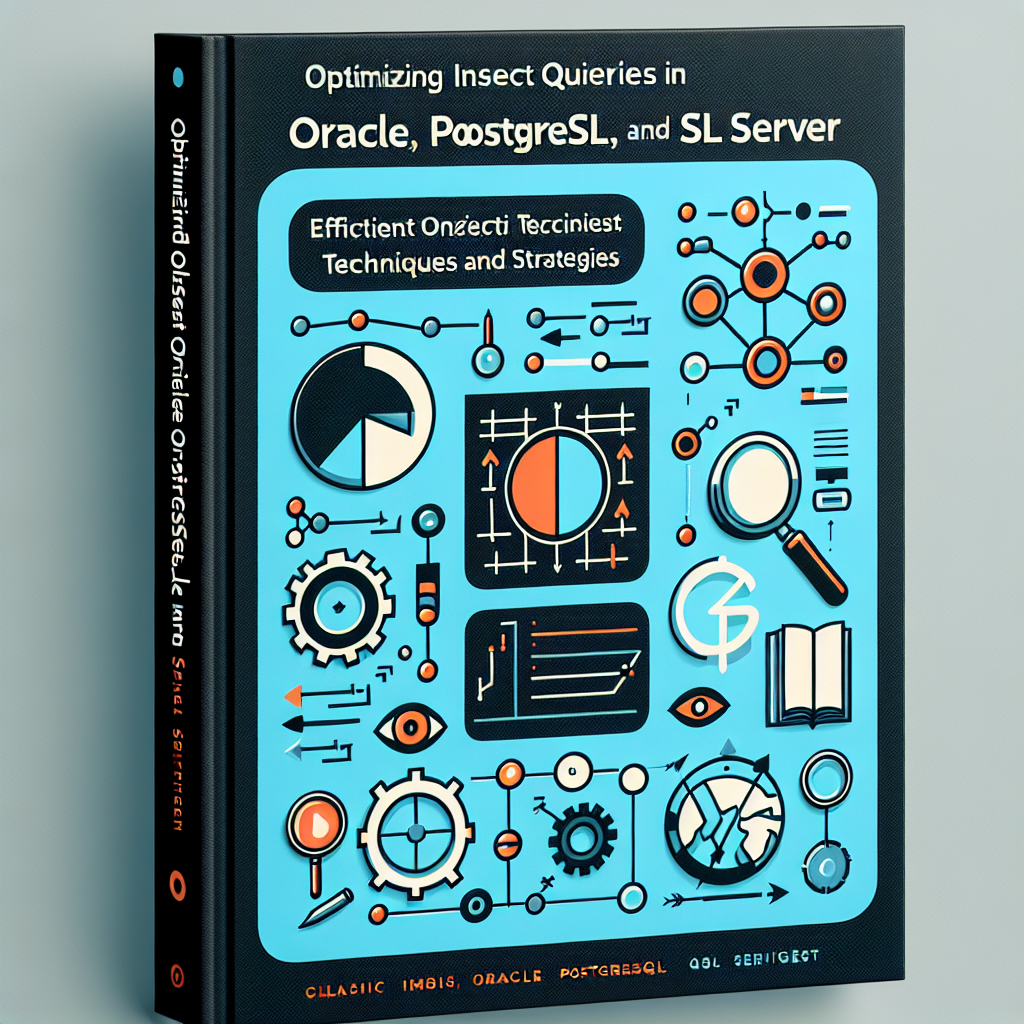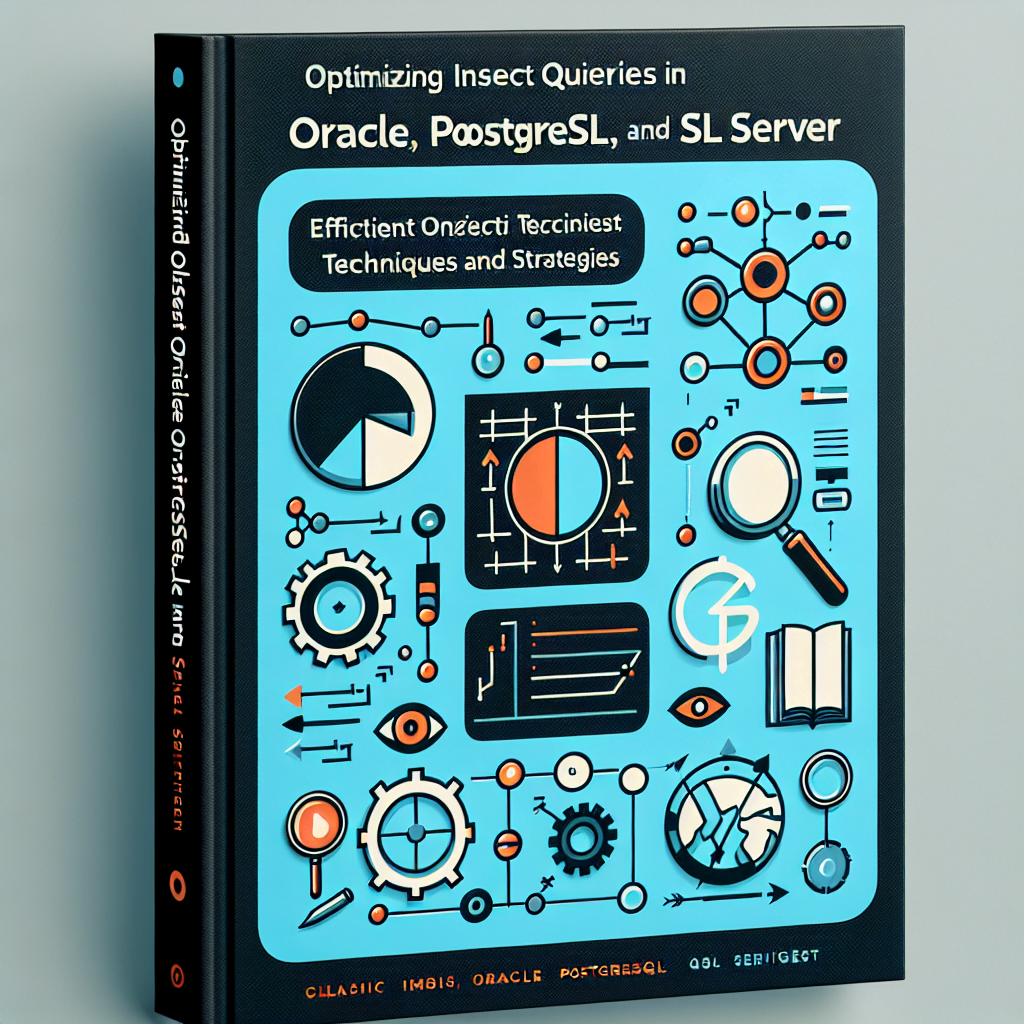Introduction to database performance and INSERT queries
Every organization that deals with data (which is pretty much all of them) relies on databases to store, retrieve, and manage that data. Among the many operations performed on these databases, the insertion of new records, facilitated through INSERT queries, is a fundamental one. However, as the volume of data grows, these INSERT operations can slow down, affecting the overall performance of your database and, subsequently, your applications. This is a common challenge faced by many professionals who work with large data sets in databases like Oracle, PostgreSQL, and SQL Server.
In this blog post, we will dive deep into the realm of database performance, focusing primarily on how to optimize slow INSERT queries. Whether you’re a database administrator looking to boost the efficiency of your database operations, a data engineer seeking ways to streamline data ingestion, or a developer striving to increase application performance, this comprehensive guide is for you.
Fasten your seatbelts as we embark on this performance-enhancing journey. We’ll decode the intricacies of INSERT queries, explore the reasons behind their slow performance, and investigate various techniques for improving their performance across Oracle, PostgreSQL, and SQL Server databases. It’s time to turn your sluggish INSERT queries into sprinting data couriers! So, let’s get started.
Understanding slow INSERT queries
What are INSERT queries?
INSERT queries are fundamental operations in any relational database management system. They serve the simple yet vital role of adding new data to the database tables. Essentially, you use an INSERT statement to introduce a new row or multiple rows of data into a specific table. While it sounds simple, the performance of these INSERT operations can significantly impact the overall efficiency and speed of your database processes.
Why are some INSERT queries slow?
Various factors can contribute to the slow performance of your INSERT queries. These may include hardware limitations, insufficient optimization, poor database design, or even the sheer volume of data being processed. For instance, the execution of triggers, the maintenance of indexes, and inefficient storage systems can all lead to a slowdown. It’s also important to note that the problem often escalates when dealing with large datasets or bulk data imports.
When INSERT queries are slow, it doesn’t just mean a momentary lag in your database operations. The slowdown can translate into significant latency, affecting the overall performance of the system and, eventually, the user experience. It might cause delays in data availability, hindering real-time analysis and decision-making processes. In the worst-case scenario, this can lead to customer dissatisfaction, missed opportunities, and lost revenues.
The Need for optimizing INSERT queries
Given the potential consequences of slow INSERT queries, it’s clear that optimizing them is not just an optional task—it’s a necessity. The goal is to ensure that your database can handle large data inserts efficiently and swiftly. Remember, the faster your database can ingest and process new data, the more agile your operations will be. So, the next question is, how can you optimize your slow INSERT queries? We will dive into this in the subsequent sections for PostgreSQL, SQL Server, and Oracle.

Optimizing slow INSERT queries in PostgreSQL
PostgreSQL, known for its extensibility and powerful features, is a popular open-source relational database management system (RDBMS). Notwithstanding its many benefits, users might encounter slow INSERT queries that could affect the overall performance. However, there are several techniques and strategies to optimize these queries and ensure the smoother functioning of PostgreSQL.
The first tip is to disable triggers and drop indexes before importing data. Contrary to what one might think, this can hugely improve the performance of your INSERT queries. The reason is simple: it eliminates the overhead of index maintenance and triggers execution during the data insertion process. This means that your system can focus more on inserting data, and less on maintaining indexes and executing triggers.
Next, consider using the COPY command instead of INSERT for bulk data loading from files. This command is particularly faster than individual INSERT statements because it loads data in a single transaction, reducing the overhead associated with multiple transactions. Meanwhile, if you have to use INSERT, try batching them into explicit transactions to enhance performance. That way, you reduce overhead by minimizing round trips between the client and the server. Finally, you can leverage PostgreSQL’s support for parallel execution by using parallel connections for INSERT or COPY. This technique can significantly improve performance, especially when dealing with large datasets.
Remember, optimizing hardware and system configuration can also have a substantial impact on INSERT performance. Using high-quality SSDs, avoiding RAID 5 or RAID 6 for direct-attached storage, and storing Write-Ahead Logs (WAL) on a separate disk can enhance the overall system performance. These strategies, when used effectively, can help you optimize slow INSERT queries in PostgreSQL and improve your database performance significantly.
Techniques for improving INSERT performance in PostgreSQL
In PostgreSQL, improving INSERT operations to optimize database performance involves a blend of strategic techniques and best practices. Here are four key techniques to help enhance the performance of INSERT commands.
- Disable triggers and drop indexes: One of the first techniques you can deploy is to disable triggers and drop indexes before performing large data imports. This action helps to reduce the overhead of index maintenance and trigger execution, which are usually performed during the insertion process. It’s a simple yet effective approach to speed up your INSERT operations.
- Use COPY command: PostgreSQL offers a powerful COPY command that allows you to load large datasets from files in a much faster way than using individual INSERT statements. By harnessing the COPY command, you can load data in a single transaction, cutting down the overhead linked with multiple transactions. It’s a game-changer when it comes to handling large datasets.
- Batch INSERT statements: Rather than performing individual INSERT statements, you can significantly speed up the process by grouping them into explicit transactions. This technique minimizes the round trips between the client and the server, thereby enhancing performance. It’s all about working smarter, not harder, to achieve your goals.
- Leverage parallel execution: Lastly, PostgreSQL supports parallel execution. This means you can carry out multiple connections to insert or copy data simultaneously. When dealing with large quantities of data, this technique can substantially boost performance.
Remember, these are just a few techniques that can be utilized to improve INSERT operations in PostgreSQL. Always consider your specific needs and database architecture when deciding on the best optimization strategies. The goal is to create a more efficient, reliable, and high-performing database system.
Optimizing slow INSERT queries in SQL Server
SQL Server, developed by Microsoft, is a prevalent relational database management system (RDBMS) used worldwide. When experiencing slow INSERT queries in SQL Server, several approaches can be used to boost performance. It’s imperative to remember that the effectiveness of these methods can vary, depending on the specific scenario and requirements. Hence, conducting a proper analysis and testing is always recommended to identify the most suitable optimization strategies.
One of the most effective ways to enhance the performance of SQL Server is performing bulk inserts. This approach consists of grouping multiple rows into a single transaction block, instead of executing individual transactions for each row. This method notably reduces the overhead associated with multiple transaction log writes, leading to a significant improvement in performance. However, this approach requires careful implementation planning to ensure optimal results.
Another recommended technique is to leverage recursive Common Table Expressions (CTEs). Recursive CTEs are beneficial for generating sample data for bulk inserts. This method reduces the number of round trips between the client and the server, thereby enhancing overall efficiency. However, it must be noted that using recursive CTEs appropriately requires a good understanding of SQL Server’s query optimization strategies.
Finally, ensuring optimal disk performance is crucial to the speed of INSERT query execution. This can be done by monitoring the average disk sec/transfer performance counter, which helps identify potential disk speed bottlenecks. Using smaller, faster disks or solid-state drives can significantly improve performance. In addition, leveraging SQL Server performance tuning tools can help identify and address potential bottlenecks or issues impacting INSERT query performance. These tools offer insights into query execution plans, index usage, and system performance metrics, providing a comprehensive evaluation of your SQL Server’s performance.
Strategies for enhancing INSERT performance in SQL Server
Bulk inserts: A way to improve speed
One of the most effective strategies to speed up INSERT queries in SQL Server is to perform bulk inserts. Rather than executing individual transactions for each row, grouping multiple rows into a single transaction block can significantly improve performance. By doing so, the overhead associated with multiple transaction log writes is reduced, leading to faster data ingestion.
Recursive common table expressions (CTEs): reducing round trips
Another valuable technique involves the use of recursive Common Table Expressions (CTEs). Recursive CTEs can be leveraged to generate sample data for bulk inserts, reducing the number of round trips between the client and the server. This technique enhances efficiency by minimizing communication times, thus speeding up the overall data import process.
Monitoring disk performance: identify performance bottlenecks
Disk performance plays a critical role in the performance of INSERT queries. Monitoring the average disk sec/transfer performance counter can help identify potential bottlenecks. Ensuring optimal disk performance is crucial for improving INSERT query execution times and overall database performance.
Evaluating index and trigger usage: Optimizing for better performance
Excessive usage of indices and triggers can slow down INSERT performance. It’s vital to analyze and optimize their usage, remove unnecessary ones, or redefine them appropriately to enhance the overall performance. Regular review and maintenance of indices and triggers can lead to improved INSERT query performance.
Utilize bulk load and staging databases: A strategy for complex operations
For complex data warehousing or Extract, Transform, Load (ETL) operations, utilizing bulk load operations and staging databases without transaction logging can dramatically improve INSERT performance. This strategy allows for efficient data loading while reducing the performance impact of logging transactions. This approach, while more advanced, can provide significant improvements for complex, large-scale data operations.
Optimizing slow INSERT queries in Oracle
Oracle, a leading RDBMS known for its robustness and scalability, often handles complex data sets and large-scale operations. Hence, optimizing slow INSERT queries in Oracle becomes crucial to maintaining overall system performance and efficiency. Here, we present several techniques that can be employed to enhance the performance of these queries.
First and foremost, using scalable sequences or pseudo-random sequence prefixes can significantly optimize the performance. In situations where multiple threads write to the same block, contention arises. This issue can be mitigated by implementing scalable sequences or creating pseudo-random sequence prefixes specific to each session. This strategy helps in avoiding contention and thus, enhancing performance.
In addition, it is advisable to disable or drop unnecessary indexes, triggers, and constraints. These elements can slow down the INSERT operations, as they add to the overhead of index maintenance and trigger execution during the insertion process. By removing these elements, the system can dedicate more resources to the actual insertion process, thereby improving performance.
Adjusting the cache size for SEQUENCE can also work wonders. If you are using a SEQUENCE for the primary key, then adjusting the cache size or using scalable sequences can optimize the performance. This reduces the number of disk I/O operations associated with fetching the next sequence value, thereby speeding up the INSERT operation.
Lastly, running multiple insert jobs in parallel can enhance performance substantially. This method allows the system to perform multiple insert operations simultaneously, thereby increasing the speed of data ingestion. However, this technique requires careful consideration of system resources and potential contention issues. It is important to balance the number of parallel insert jobs to avoid overloading the system.
To sum up, boosting the performance of slow INSERT queries in Oracle involves a combination of strategies tailored to your specific scenario and requirements. These techniques, coupled with regular monitoring and adjustments, can greatly enhance the performance and efficiency of your Oracle database system.
Techniques for boosting INSERT performance in Oracle
When dealing with Oracle, a robust and highly scalable relational database management system, there are a handful of techniques that can significantly enhance the performance of slow INSERT queries. To kick things off, one of the most effective techniques involves the use of scalable sequences or pseudo-random sequence prefixes. In simple terms, contention is an occurrence that transpires when multiple threads attempt to write to the same block. By utilizing scalable sequences or generating pseudo-random sequence prefixes for each session, you can successfully dodge contention, boosting your overall performance.
Secondly, taking the time to remove any unnecessary indexes, triggers, and constraints can bring about a considerable improvement in your INSERT performance. It’s worth noting that these elements can create an overhead during the insertion process, particularly when it comes to trigger execution and index maintenance. By disabling or dropping the superfluous ones, you can effectively reduce this overhead, thereby enhancing the insertion process.
Adjusting the cache size for SEQUENCE is another technique that you might find beneficial, especially if you’re using a SEQUENCE for the primary key. This is an effective way to optimize performance as it reduces the number of disk I/O operations that are associated with fetching the next sequence value. In essence, this means that the database system won’t have to work as hard, which can lead to a noticeable increase in performance.
Running multiple insert jobs in parallel can also serve to improve performance. This method allows you to capitalize on the power of parallelization by running several insert jobs at once. However, it’s crucial to carefully consider your system resources and potential contention issues before jumping into this strategy. While it can be highly effective, it’s not without its challenges.
Last but not least, inserting values into the Oracle database can be optimized by batching the data and using the bulk load operations. This involves grouping multiple rows into a single transaction block which can significantly reduce the overhead associated with multiple transaction log writes and ultimately improve the time taken for INSERT operations. To sum up, optimizing slow INSERT queries in Oracle is achievable through a series of strategic steps and techniques, all of which contribute to a more efficient and streamlined data ingestion process.
Common practices for optimizing INSERT queries across databases
Regardless of the specific database system you’re working with, there are a few general practices that can expedite the INSERT process. One such practice involves the evaluation and moderation of triggers and indexes. While triggers and indexes are crucial database components, excessive or unnecessary usage can slow down the INSERT operation by adding additional overhead. Therefore, critically examining and optimizing their usage can significantly enhance performance.
Batching INSERT statements into explicit transactions is another common practice that applies to most databases. Instead of executing individual INSERT statements, combining them into explicit transactions can substantially boost performance. This process reduces overhead by curtailing the number of round trips between the client and the server. In addition, using bulk data loading methods instead of individual INSERT statements whenever feasible can also lead to significant performance improvements.
In addition to these strategies, one cannot overlook the importance of hardware and system configuration in optimizing database performance. For example, using high-quality SSDs, avoiding RAID 5 or RAID 6 for direct-attached storage, and storing Write-Ahead Logs (WAL) on a separate disk can yield noticeable improvements in INSERT operation speed. Moreover, monitoring disk performance and ensuring optimal disk speed can prevent potential bottlenecks that could slow down INSERT operations.
Lastly, don’t forget the significance of tools and resources provided by the database systems themselves. For instance, SQL Server offers performance tuning tools that provide valuable insights into query execution plans, index usage, and system performance metrics. These tools can help identify and address potential issues impacting the speed of your INSERT queries. Remember, these are general practices and their effectiveness may vary based on the specific database system and the unique requirements of your operation. Therefore, always combine these practices with system-specific strategies for the best results.
Conclusion and final thoughts on database performance optimization
Improving database performance is an ongoing task that involves consistent monitoring and optimization to ensure efficiency and reliability. In this post, we’ve explored the challenges surrounding slow INSERT queries and shared various strategies to optimize them in PostgreSQL, SQL Server, and Oracle.
It’s important to understand that not all slow INSERT queries are created equal, and what works in one scenario or for one database might not necessarily work in another. It’s crucial to understand the root cause of the slowness before deciding which optimization method would be the most suitable.
In PostgreSQL, using COPY command, bulk inserts, and reducing the number of indexes can lead to significant improvements in INSERT performance. In SQL Server, strategies like using minimal logging, batch inserts, and optimizing the fill factor can enhance the performance of INSERT queries. Meanwhile, in Oracle, techniques such as multiplexing redo log files, using direct-path INSERT, and using NOLOGGING option can greatly boost the performance of INSERT queries.
Lastly, remember that optimizing database performance is not a one-size-fits-all process. It requires a deep understanding of your database’s specific needs and behaviors. Therefore, regular monitoring, testing, and optimization should be part of your database management routine.
In conclusion, investing time and effort in optimizing your INSERT queries can result in significant improvements in your database performance, leading to more efficient, reliable, and scalable applications. With the right strategies and continuous optimization, you can ensure your database system performs at its best.
If you do not know how to partition tables or want professional help, you are in the right place. Contact us for help and our experts will do table partitioning and answer all your questions related to databases.

